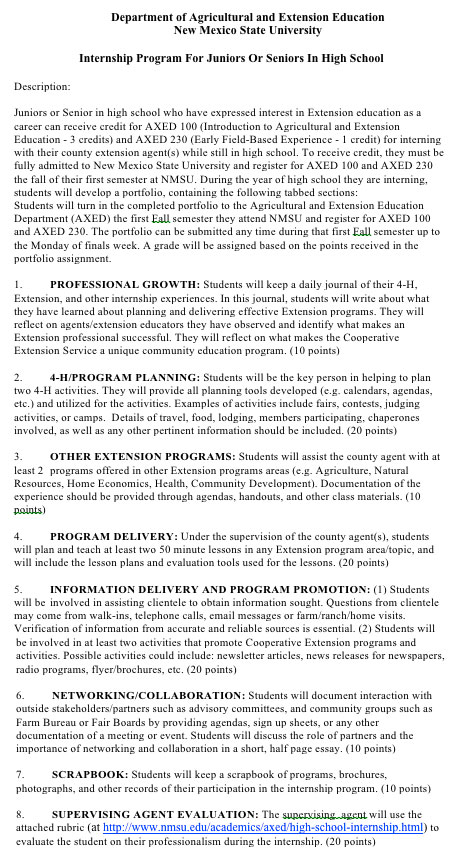 |
December 2010
|
December 2010 // Volume 48 // Number 6 // Ideas at Work // v48-6iw1
Turning an Extension Aide into an Extension Agent
Abstract
For any organization to remain sustainable, a renewable source of faculty and staff needs to be available. The Extension Internship Program for Juniors and Seniors in High School is a new tool for recruiting and developing new Extension agents. Students get "hands on" experience working in an Extension office and earn college credit while in high school.
Introduction
In order for any organization to survive, it will need to recruit and develop many new personnel. The Cooperative Extension Service is no exception. New agents are needed to replace those who will leave the profession. To provide the staff necessary to support continuing and future endeavors, Cooperative Extension leaders are challenged to think of new recruitment and development strategies. Internships have long been a way to recruit a potential workforce. But to date, most internships have been centered on college-age students. (Wilken, Williams, Cadavieco, & Walker, 2008; Rogers, Mason, & Connelius, 2001; Seevers, Treat, Cummings, & Wright, 1996). According to Borkowski (2009), internships during high school provide a full range of benefits to both the organizations and the student, like work experience, career orientation, resume building, and a potential future workforce.
For New Mexico, we conceptualized the Extension Internship Program for Juniors and Seniors in High School as one new tool for recruiting and developing new agents. Our idea is for Extension agents to identify talented youth who have the interest and potential to become quality Extension agents as their aides. Duties are structured and supervised/mentored by their Extension agent to give the interns a comprehensive look at and successful experiences with the role of an extension agent. Interns get real experiences in the different Extension program areas as well as the delivery strategies for successful community education.
Grading Rubric for College Credit
Upon entering college, the student receives college credit for their internship by submitting a portfolio. Our instructions and grading rubric for interns compiling, and university faculty assessing internship portfolios for college credit are shown in Figure 1.
Figure 1.
Grading Rubric

Benefits of the Program
This program has multiple wining aspects with no apparent downside. Some of these aspects are the following.
- Agents get involved in building their future workforce.
- Rich and meaningful experiences are provided to high school students with the interest and potential to become quality Extension agents.
- Agents get the satisfaction and experience of mentoring their own youth toward a career in Extension.
- Agents get more assistance with their program.
- Youth get four credits towards their college education.
- Partnership links between Extension, agents, youth, and university agricultural educators are established when the youth are still in high school.
- The most motivated youth start early on a pathway to become an Extension agent.
- Students could apply internship experiences towards scholarships, record book, and leadership awards.
- Students enroll in a full load of courses their first semester in college, but in reality only attend four classes because they have already completed the work for four credits.
- The program is simple to understand and requires little additional paperwork for the Extension agent.
- Additional costs for the internship should be minimal to non-existent.
Final Notes
While we don't anticipate that the program will completely solve the shortage and demand for additional agents, it could make a sizable contribution. Just think if each current Extension agent identified and worked with one student over the next 3 years in such an internship. We'd have the potential to add hundreds of new agents to the workforce with this simple tool, alone!
References
Borkowski, S. (2009). Internships for high school students. FastWeb. Career Connections. Retrieved November 10, 2010 from: http://www.fastweb.com
Rogers, B., Mason, K., & Cornelius, J. (2001). Involving undergraduate students as Extension program interns. Journal of Extension. [On-line], 39(5) Article 5IAW4. Available at: http://www.joe.org/joe/2001october/iw4.php
Seevers, B.S., Treat, K., Cummings, M., & Wright, S. (1996). Building bridges: Leadership development for the 21st century. Journal of Extension. [On-line], 34(4) Article 4FEA3. Available at: http://www.joe.org/joe/1996august/a3.php
Wilken, C.S., Williams, B.C., Cadavieco, N., & Walker, D.K. (2008). Student internships in Extension: Strategies for success for the agent and the student. Journal of Extension. [On-line], 46(4) Article 4TOT3. Available at: http://www.joe.org/joe/2008august/tt3.php




